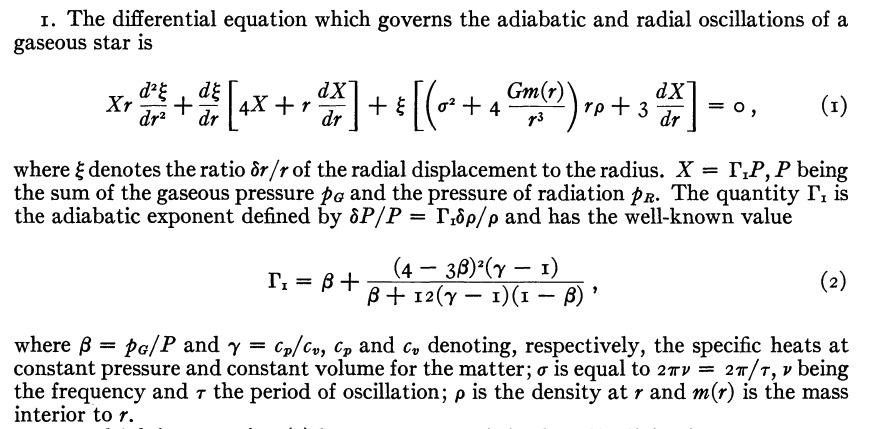Difference between revisions of "User:Tohline/SSC/VariationalPrinciple"
| Line 122: | Line 122: | ||
</table> | </table> | ||
</div> | </div> | ||
This is identical to equation (58.1) of Ledoux & Walraven. | This is identical to equation (58.1) of [http://adsabs.harvard.edu/abs/1958HDP....51..353L Ledoux & Walraven (1958)]. | ||
==Review by Ledoux and Walraven== | ==Review by Ledoux and Walraven== | ||
Revision as of 01:26, 28 May 2017
Ledoux's Variational Principle

|
|---|
| | Tiled Menu | Tables of Content | Banner Video | Tohline Home Page | |
All of the discussion in this chapter will build upon our derivation elsewhere of the,
LAWE: Linear Adiabatic Wave (or Radial Pulsation) Equation
|
<math>~ \frac{d^2x}{dr_0^2} + \biggl[\frac{4}{r_0} - \biggl(\frac{g_0 \rho_0}{P_0}\biggr) \biggr] \frac{dx}{dr_0} + \biggl(\frac{\rho_0}{\gamma_\mathrm{g} P_0} \biggr)\biggl[\omega^2 + (4 - 3\gamma_\mathrm{g})\frac{g_0}{r_0} \biggr] x = 0 </math> |
We will draw heavily from the paper published by Ledoux & Pekeris (1941), and from pp. 458-474 of the review by P. Ledoux & Th. Walraven (1958) in explaining how the variational principle can be used to identify the eigenvector of the fundamental mode of radial oscillation in spherically symmetric configurations.
Ledoux and Pekeris (1941)
Historically, by the 1940s, the LAWE was a relatively familiar one to astrophysicists. For example, the opening paragraph of a 1941 paper by Ledoux & Pekeris (1941, ApJ, 94, 124), reads:
|
Paragraph extracted from P. Ledoux & C. L. Pekeris (1941)
"Radial Pulsations of Stars"
ApJ, vol. 94, pp. 124-135 © American Astronomical Society |
If we divide their equation (1) through by <math>~Xr = \Gamma_1 P r</math> and recognize that,
<math> \frac{dX}{dr} = \frac{dX}{dm}\frac{dm}{dr} = - \Gamma_1 g_0 \rho \, , </math>
we obtain,
<math> \frac{d^2\xi}{dr^2} + \biggl[ \frac{4}{r} - \frac{g_0 \rho}{P} \biggr] \frac{d\xi}{dr} +\frac{\rho}{\Gamma_1 P} \biggl[ \sigma^2 + (4 - 3\Gamma_1) \frac{g_0}{r} \biggr] \xi = 0 \, . </math>
Clearly, this 2nd-order, ordinary differential equation is the same as our derived LAWE, but with a more general definition of the adiabatic exponent that allows consideration of a situation where the total pressure is a sum of both gas and radiation pressure.
Multiplying this last equation through by <math>~\Gamma_1 P r^4</math>, and recognizing that,
|
<math>~(r^4 \Gamma_1 P)\frac{d^2\xi}{dr^2} </math> |
<math>~=</math> |
<math>~ \frac{d}{dr}\biggl[ r^4 \Gamma_1 P ~\frac{d\xi}{dr} \biggr] - \frac{d\xi}{dr} \cdot \frac{d}{dr} \biggl[ r^4 \Gamma_1 P\biggr] </math> |
we can write,
|
<math>~0</math> |
<math>~=</math> |
<math>~ \frac{d}{dr}\biggl[ r^4 \Gamma_1 P ~\frac{d\xi}{dr} \biggr] - \frac{d\xi}{dr} \cdot \frac{d}{dr} \biggl[ r^4 \Gamma_1 P\biggr] + ( \Gamma_1 P r^4 ) \biggl[ \frac{4}{r} - \frac{g_0 \rho}{P} \biggr] \frac{d\xi}{dr} +\rho \biggl[ \sigma^2 r^4 + (4 - 3\Gamma_1) g_0 r^3\biggr] \xi </math> |
|
|
<math>~=</math> |
<math>~ \frac{d}{dr}\biggl[ r^4 \Gamma_1 P ~\frac{d\xi}{dr} \biggr] - \biggl[4r^3\Gamma_1 P + \Gamma_1 r^4 \frac{dP}{dr} \biggr] \frac{d\xi}{dr} + \biggl[ 4 r^3\Gamma_1 P + \Gamma_1 r^4 \frac{dP}{dr}\biggr] \frac{d\xi}{dr} +\biggl[ \sigma^2 \rho r^4 - (4 - 3\Gamma_1) r^3 \frac{dP}{dr} \biggr] \xi </math> |
|
|
<math>~=</math> |
<math>~ \frac{d}{dr}\biggl[ r^4 \Gamma_1 P ~\frac{d\xi}{dr} \biggr] +\biggl[ \sigma^2 \rho r^4 + (3\Gamma_1 - 4) r^3 \frac{dP}{dr} \biggr] \xi \, . </math> |
This is identical to equation (58.1) of Ledoux & Walraven (1958).
Review by Ledoux and Walraven
P. Ledoux & Th. Walraven (1958) discuss linearization of the principal governing equations and stellar pulsation primarily from an Eulerian perspective. Focusing on §57 (pp. 455 - 458) of their Handbuch der Physik article — which falls under the major heading, "Radial oscillations of a gaseous sphere under its own gravitation" — we note, first that they use <math>~\delta r</math> to denote the radial displacement and use primes to identify all Eulerian perturbations. Then, in separating out the spatial and time dependences, they use the notation (see their equation 57.14),
Chandrasekhar (1964)
S. Chandrasekhar (1964, ApJ, 139, 664)
See Also

|
|---|
|
© 2014 - 2021 by Joel E. Tohline |
